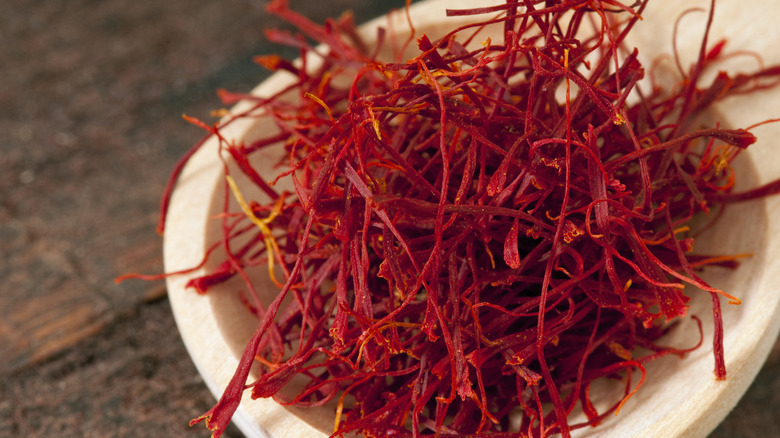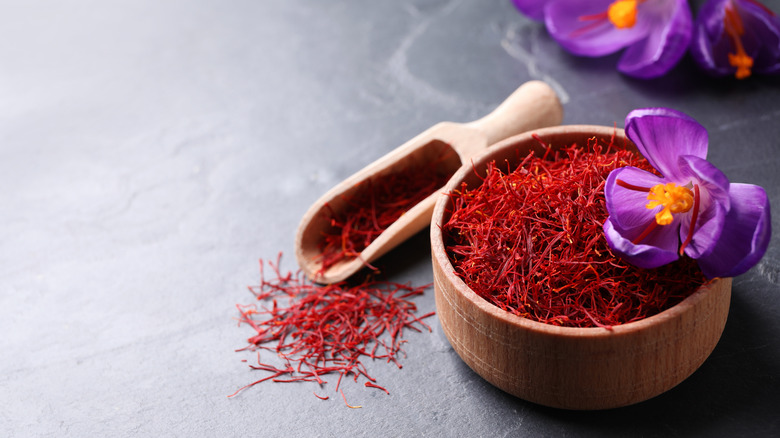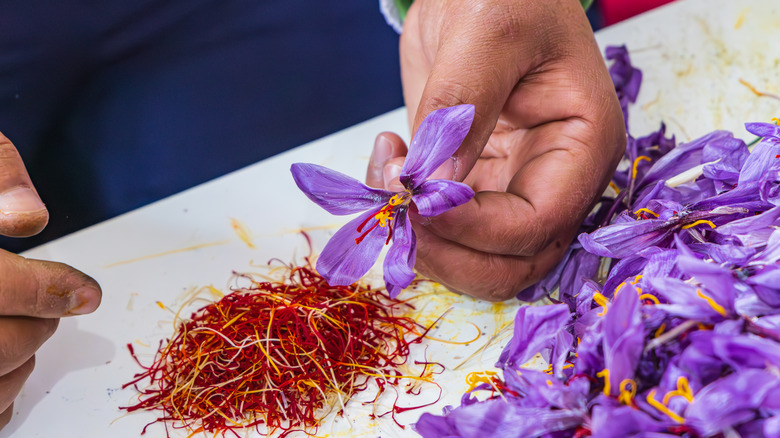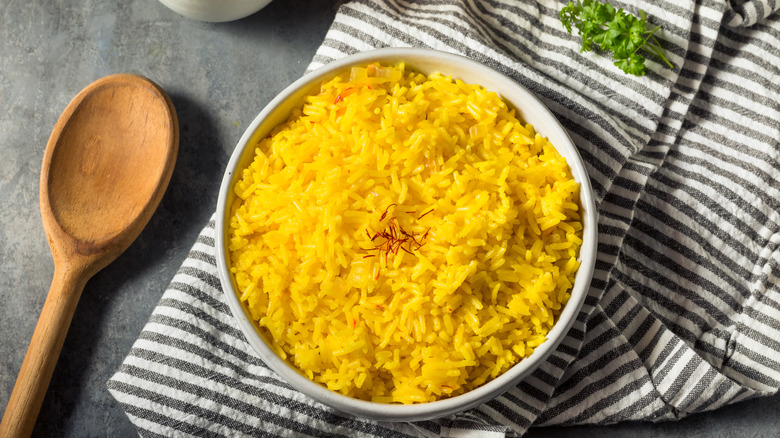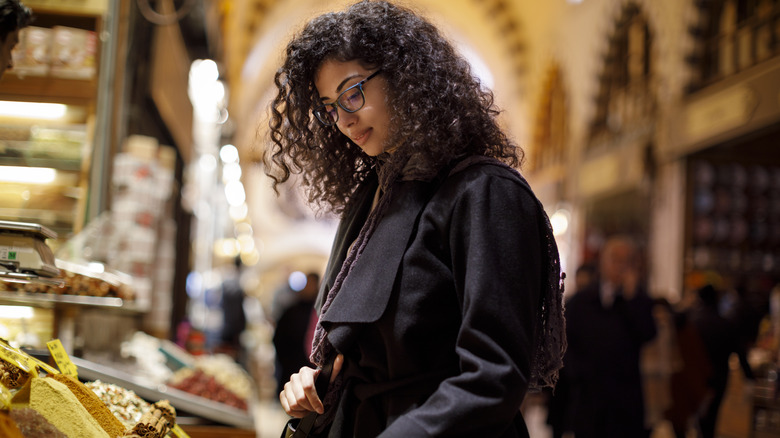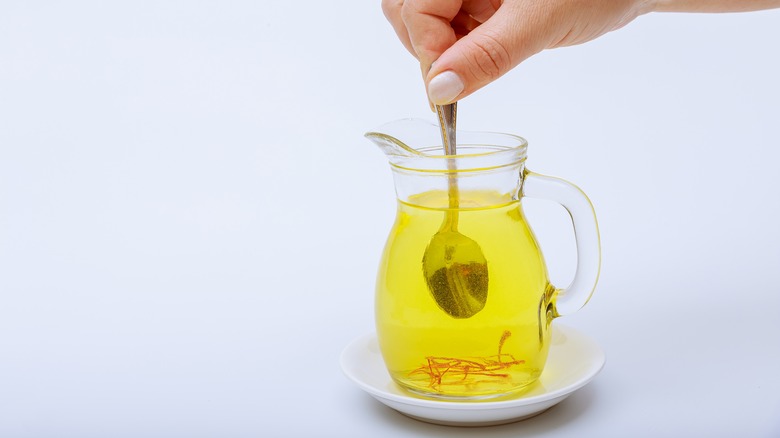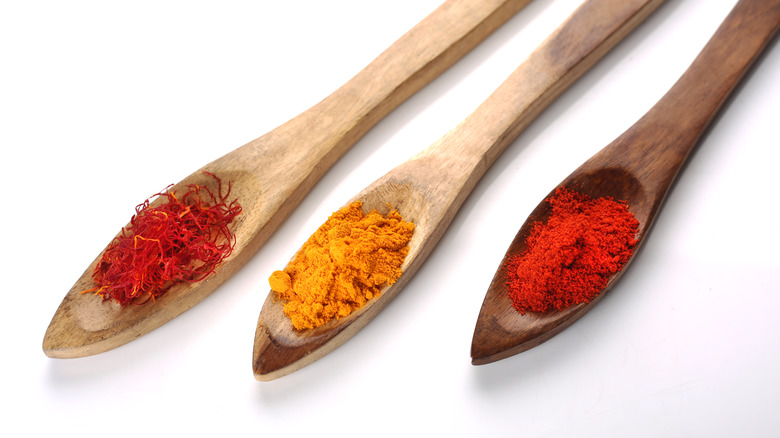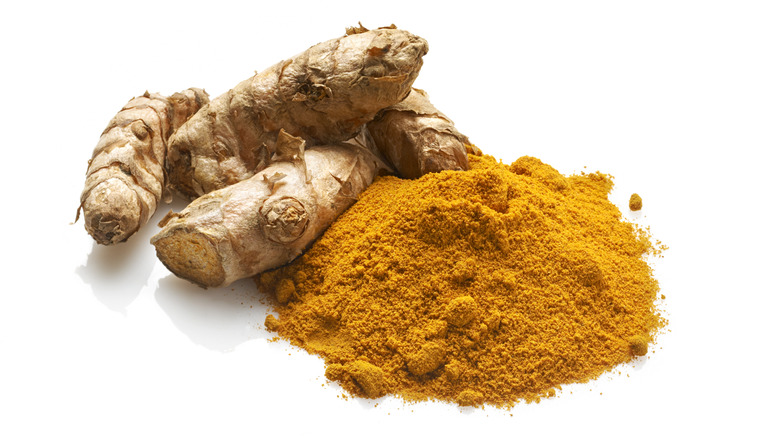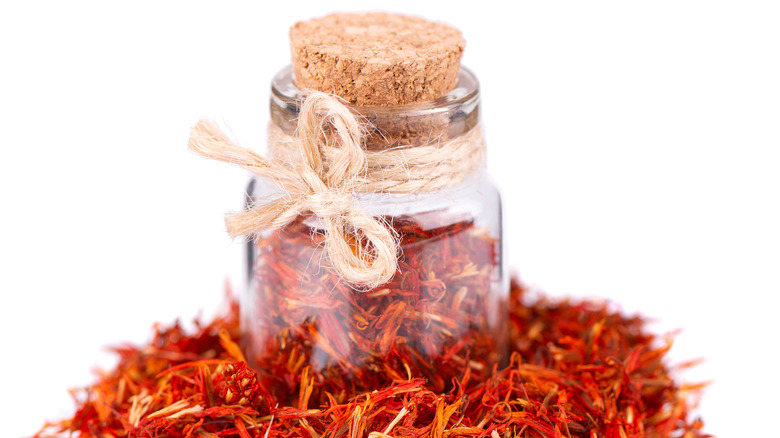What Is Saffron And How Do You Use It?
Saffron is one of the world's most highly-regarded spices, and a key part of cuisines from India to Iran, France, and Spain (well, at least in paella). It adds a subtle yet distinct taste to dishes, and despite its deep red color, it's used to add a golden yellow hue to dishes.
With the scientific name Crocus sativus, saffron plants only flower for a few days a year (and those flowers are integral to the spice), making it difficult to produce en masse, particularly when you factor in the hefty volume of flowers required to produce even a little bit of it. As such, it's also really, really expensive, costing upwards of $10,000 per pound. With such high prices, it's unsurprising that fake saffron is relatively common, and entities peddling counterfeit versions of the spice have been known to traffic it in the millions of dollars. With such high prices (and the chance of accidentally buying the fake stuff), you'll want to know exactly what to look for, as well as how to use it properly.
What is saffron?
Saffron is a spice used to flavor and color a variety of dishes in Asian and European cuisines. An ancient spice, it's believed to have originated from within modern-day Iran, and much of the world's saffron production still comes from there. At present, it tends to be grown in drier (but not desert) areas from Spain, Morocco, and Greece in the West, over to Iran, India, and Afghanistan in the East.
Saffron plants are part of the iris family (think of iris flowers), and there aren't really any other commonly used ingredients that come from similar plants — iris plants tend to be used more in the perfume industry. The kind you buy in the store consists of just the stigma from the saffron flower — a small stalk that helps the plant catch pollen for its own reproduction. These stigmas, usually referred to as "threads," are very thin and delicate and can be a little over an inch long. The threads are usually deep red in color, sometimes with a tiny yellow or orange stem at the end — it's generally considered of higher quality if it doesn't have these yellow parts, though.
How is saffron made?
Part of the reason saffron is a luxury ingredient is because of how labor-intensive it is to harvest. Only three threads can typically be drawn from a single saffron flower, and not only do these need to be plucked by hand, there's only about a week or two per year in which this can be done. And remember, those threads are tiny: You need around 150 flowers to get just one gram of saffron.
To produce saffron, you need to grow the saffron crocus plant. When it flowers (in the Northern hemisphere's fall), it's harvesting time. The flowers are removed from the plant, ideally in the morning, before the plant fully opens up and exposes the stigmas to damaging sunlight. Farmers then need to get the stigmas (that is, the saffron threads) out of the flowers, either delicately with their hands, or with tweezers. The saffron is then left to dry for a few hours (this extends its life substantially), and then can be packaged and shipped off to consumers.
What does saffron taste like?
Saffron is known both for its distinctive yet subtle taste and smell — although culinary experts often say the exact flavor of saffron is hard to pin down. It's a kind of nuanced mix of various flavor hints: a wee bit bitter, a touch sweet and floral, with a hint of earthiness. Speaking to food news site Eater, one spice retailer suggested the saffron is less of a "flavor" and more of a "presence." These descriptions carry over to its aroma, which is also lightly bittersweet, maybe with a dash of earthy hay. Saffron tends to not appear on its own in dishes — it's a team player, used in conjunction with other ingredients.
The unique taste and scent of saffron aren't its only drawcard; saffron is also valued for the golden color it adds to food — think about saffron rice you might have encountered in Indian or Iranian cuisine. Of course, if you're using darkly-colored ingredients in a dish, they may overpower the brighter yellow tones that saffron adds.
How to cook with saffron
If you're cooking with saffron, use it sparingly, as it can overpower dishes — as little as a couple of threads per serving is a useful guideline. It's popular as an addition to rice, where it adds both a glorious golden color and a deep layer of extra flavor – recipes from Persian-style tahdig (a crispy, buttery rice dish that goes well with stews) to paella are a common backdrop for saffron. But beyond rice, there's a wide range of dishes where it can appear, from the savory Moroccan meat pie b'stilla to hearty, meaty Iranian stews or classic southern French bouillabaisse (seafood soup). It's more common in recipes from the Mediterranean through to Iran, India, and Afghanistan, reflecting the areas where it's produced. It's not just a savory spice, either — the Iranian dessert bastani is a saffron-laced ice cream with rose water and pistachios.
A popular approach to cooking with saffron is to grind it and soak it in a small amount of warm water with a pinch of sugar and salt (if you're using a spice mill, be sure it's clean so that other flavors don't seep in). Warm stock or milk are also good options for steeping if they work with the recipe you're making; 15 to 30 minutes is typically enough, then use the bloomed saffron liquid in your recipe as normal.
Where to buy saffron
Saffron shouldn't be too hard to find: Many (but not all) supermarkets carry it, including Whole Foods. Middle Eastern or Iranian grocery stores are also a good bet, as well as specialty stores for South Asian/Indian food, or Mediterranean cuisines. If you're particularly concerned about quality, it might be wise to head to a specialty spice store, as they may be more attentive when it comes to sourcing quality saffron.
Online shopping is also an option — there's no shortage of saffron on Amazon, but just like in the real world, you may be better off opting for a retailer (or at least an Amazon seller) that focuses on spices, for the sake of quality. It's possible to buy ground saffron instead of the typical threads, but this makes the saffron lose its potency faster, so it's probably not advisable. If that's not reason enough to avoid powdered saffron, it's also easier for less reputable companies to pad it with cheap filler ingredients. Aim to buy saffron threads in sealed (or double-sealed) containers as these help keep it fresh.
Nutritional information about saffron
Since saffron is typically used in such tiny amounts in cooking, it's not really a major source of nutrients like fiber, protein, vitamins, and so forth. However, it may still provide health benefits. The best-known of these is that it's an antioxidant. Antioxidants counteract a type of by-product in your body called a free radical. Free radicals occur naturally and can fight viruses, but if they build up, they can also contribute to kidney failure, arthritis, and hypertension (among other problems) according to Health Direct.
There may be other health benefits of saffron, although the research is often too small bore to be widely recommended. Some studies vetted by the Cleveland Clinic have suggested that saffron could relieve some premenstrual syndrome symptoms like headaches and irritability, and Healthline points to other studies where it's been seen as useful in quelling mild-to-moderate depression symptoms. The outlet even highlights some small-scale studies where it performed better than a placebo for aiding with erectile dysfunction.
Fake vs real saffron: Can you detect it?
Since saffron is so expensive, there's a robust market for fake versions of the spice (sometimes called "adulterated" saffron) — but there are a few ways you can avoid getting duped. First, only buy saffron threads and avoid the powdered stuff: It may be cheaper, but it's more likely to be padded with other ingredients (often paprika or turmeric).
Also, check out the price tag. In the U.S., expect to pay $10 to $20 per gram of real saffron. If it's below that, it's probably too good to be true. And, finally, you can do a smell test; saffron should have the distinctive, slightly sweet smell of flowers. You can also drop a thread into hot water: If the water starts turning red, you may have a lesser product that's been dyed (and the dye is seeping out). The water should ideally turn yellow, and this may take a few minutes.
Saffron vs turmeric: a cheaper alternative?
If you can't get saffron or if you simply don't want to pay the high price tag for it, turmeric is often put forward as a substitute ingredient (and some questionable retailers have even been known to cut their saffron with turmeric to keep costs down). If you're simply looking for the vibrant yellow or gold color that saffron offers (say, to add to some rice), turmeric may suffice, but beyond that, it's not a great substitute. Turmeric comes from the roots of a plant in the ginger family, so it's fundamentally not that close to saffron in taste.
As a root, it does offer some of the earthy notes that are present in saffron threads, but other elements that define the ingredient (such as its sweet, floral nature) aren't really present in turmeric. Ultimately, the flavors just aren't that similar, and you could be running the risk of ruining a recipe subbing in turmeric.
How to store saffron
Saffron threads can last for up to three years if you store them correctly. It's best to keep them in a small, sealed, airtight container and stash it somewhere cool and dark in your kitchen. Moisture is the main enemy, so make sure that the container is dry as a bone. It's possible to store it in the freezer for up to a year (also in an airtight container), although views on this are mixed: Some say it can extend the life of saffron, others say it can affect the flavor and scent, for example, through freezer burn. Realistically, it should be fine outside of the freezer unless you live in an unusually warm or humid area.
If you've made saffron water (by soaking saffron in hot water, which you'll then use for cooking), it can be stored in the refrigerator for around three weeks — and, again, a sealed container is best.
